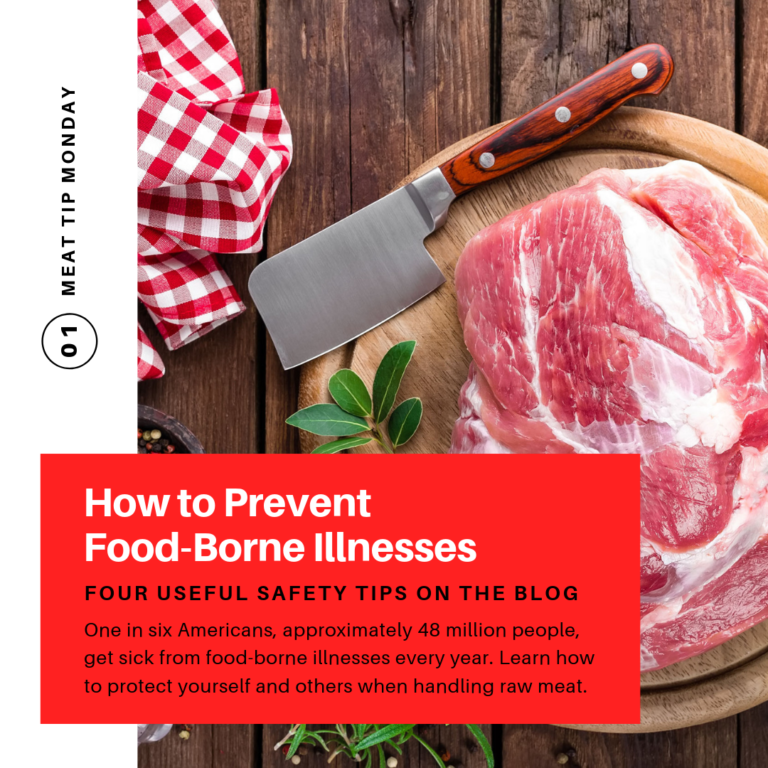
How to Prevent Food-Borne Illnesses
08.26.2019• Tips & Tricks
Welcome to our new series
Meat Tip Monday
On Mondays, we’ll share a tip to improve your grilling game, cooking abilities, and knowledge of preparing meat dishes. We hope you find these tips helpful and you use them in your kitchen, on the grill, or wherever you’re cooking!
For the first Meat Tip Monday, we thought it was fitting to introduce the series with a food safety tip – because safety always comes first! It’s crucial to practice food safety, especially when handling raw meat, to prevent food-borne illnesses. Food-borne illnesses cause one in six Americans, approximately 48 million people, to get sick from every year, according to the U.S. Center for Disease Control and Prevention (CDC). In this blog post, you’ll learn four safety tips to protect yourself and others from food-borne illnesses when handling raw meat.
1. Wash your hands, surfaces, and cooking tools
Always wash your hands before and after handling raw meat; wash your hands with soap and warm water for at least 20 seconds then dry with a clean paper towel or hand cloth.
Don’t skip out on this simple task by using hand sanitizer as alcohol-based hand sanitizers are not a replacement for handwashing. Hand sanitizer is not effective Norovirus, a very contagious virus that causes vomiting and diahea. Hand sanitizer also does not eliminate all types of infectious microorganisms. (Source)
It’s not only important to wash your hands, it’s also necessary to wash your prep surfaces and cooking tools. Wash prep surfaces and all cooking tools, whether they be cutting boards, dishes, or utensils, with warm, soapy water after handling raw meat. It’s also best to wash prep surfaces and cooking tools after preparing each food item and before you use it for the next food item. To do so, wash with hot, soapy water, rise with hot water, and either air dry or dry with a clean paper towel or clean dish cloth. You can wash dishes and cooking utensils in the dishwasher as well.
2. Separate raw meat to prevent cross-contamination
Keep raw meat separate from other other raw meats, ingredients, prep surfaces, and cooking tools to prevent cross-contamination. Cross-contamination is the transfer of harmful bacteria from raw meat, other uncooked food products, or unsanitary people, surfaces, and cooking tools to ready-to-eat foods, such as fruits, vegetables, deli meats and cheeses, and cooked foods.
You can also prevent cross-contamination when grocery shopping and storing raw meat in the refrigerator. Physically separate raw meat to prevent its juices from dripping onto other foods by:
- Segregating raw meat on one side of the shopping cart and ready-to-eat foods on the other side
- Placing raw meat in separate plastic bags: one bag chicken, one bag for fish, etc.
- Designate reusable bags for grocery shopping only. Reusable bags for raw meat should never be used for ready-to-eat foods.
- Frequently wash reusable cloth bags; they should be washed in a washing machine and machine dried or air dried. Plastic-lined reusable bags should be scrubbed with hot, soapy water and air dried.
3. Cook raw meat to the correct temperature
Cook raw meat thoroughly to the safe minimum internal temperature listed below:
- Beef, pork, lamb, and veal (steaks, chops, roasts, etc.): 145°F and let rest for at least 3 minutes
- Ground meat: 160°F
- All poultry (whole, breast, wings, thighs, ground, and stuffing): 165°F
- Fish and shellfish: 145°F
- Eggs: 160°F
- Leftovers: 165°F
- Casseroles: 165°F
To determine if the proper temperature was reached, place a food thermometer in the thickest part of the food and allow it to equilibrate and follow these guidelines:
- Make sure the thermometer is not touching any bones, fat, or gristle
- For whole poultry, insert the thermometer into the innermost part of thigh and wing as well as the thickest part of the breast
- For combination dishes, place the thermometer in the center or thickest portion
- Check egg dishes and dishes containing ground meat or poultry in several places
Always clean your food thermometer with hot, soapy water before and after each use.
4. Chill raw meat as soon as possible
After purchasing raw meat, you must chill the meat promptly at a temperature at 40°F or below. This is because cold temperatures slow the growth of harmful bacteria. It’s important to not overfill your refrigerator or freezer as cold air must circulate to keep the raw meat safe to eat. Place an appliance thermometer in the back of the refrigerator and monitor its temperature regularly. If you choose to store raw meat in the freezer, maintain its temperature at 0°F or below.
After storing raw meat in the freezer, use one of these three methods to safely thaw the meat:
- Submerge the raw meat in cold water. It’s essential to place the meat in a plastic bag that won’t allow water inside. Check the water every 30 minutes to make sure it is cold. Raw meat thawed using this method must be cooked immediately.
- Microwave the raw meat. Cook the raw meat immediately once thawed because some areas of the meat may become warm and begin to cook during the thawing process.
- Thaw in the refrigerator. Place the raw meat in a plastic bag or on a place on the lowest shelf of the refrigerator to prevent its juices from dripping onto other food products. After thawing in the refrigerator, raw meat will still be of good quality and safe to consumer for a few days before cooking. Raw meat thawed in the refrigerator can be refrozen without cooking; however, the quality may decrease.
We hope you found these four safety tips on how to prevent food-borne illnesses helpful and you use them to protect yourself and others when handling raw meat. Stay tuned for more Meat Tip Monday blog posts!
Sources
U.S. Center for Disease Control and Prevention (CDC)
The University of Rhode Island
